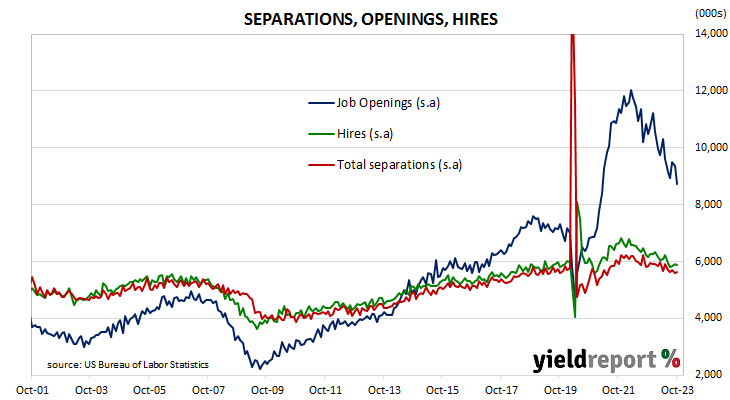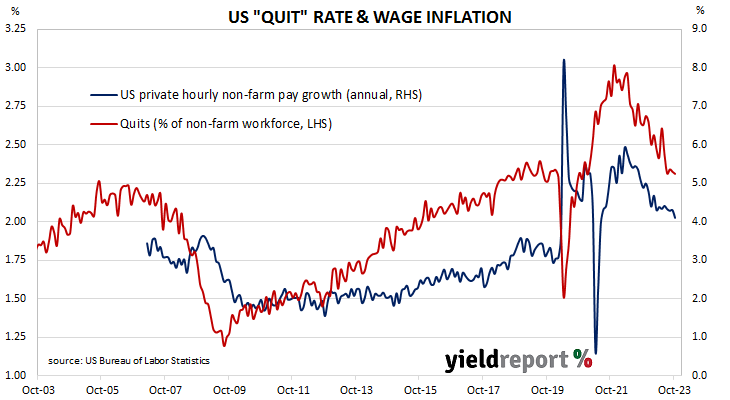Summary: US quit rate steady at 2.3% in October; US Treasury yields fall noticeably; expectations of Fed rate cuts in 2024 firm; fewer quits, openings, more separations; ANZ: conditions for FOMC rate cuts gradually falling into place.
The number of US employees who quit their jobs as a percentage of total employment increased slowly but steadily after the GFC. It peaked in March 2019 and then tracked sideways until virus containment measures were introduced in March 2020. The quit rate then plummeted as alternative employment opportunities rapidly dried up. Following the easing of US pandemic restrictions, it proceeded to recover back to its pre-pandemic rate in the third quarter of 2020 and trended higher through 2021 before easing through 2022 and the first half of 2023.
Figures released as part of the latest Job Openings and Labor Turnover Survey (JOLTS) report show the quit rate remained steady in October. 2.3% of the non-farm workforce left their jobs voluntarily, unchanged from September after rounding. Quits in the month declined by 18,000 while an additional 150,000 people were employed in non-farm sectors.
The report was released on the same day as the latest ISM services PMI reading and US Treasury yields fell noticeably on the day. By the close of business, the 2-year Treasury bond yield had lost 6bps to 4.58%, the 10-year yield had shed 9bps to 4.18% while the 30-year yield finished 12bps lower at 4.31%.
In terms of US Fed policy, expectations of a lower federal funds rate in the next 12 months firmed. At the close of business, contracts implied the effective federal funds rate would average 5.33% in December, in line with the current spot rate, 5.335% in January and 5.245% in March. November 2024 contracts implied 4.225%, 100bps less than the current rate.
The fall in total quits was led by 62,000 fewer resignations in the “Retail trade” sector while the “Professional and business services” sector experienced the largest gain, rising by 97,000. Overall, the total number of quits for the month decreased from September’s revised figure of 3.646 million to 3.628 million.
Total vacancies at the end of October dropped by 617,000, or 6.6%, from September’s revised figure of 9.350 million to 8.733 million. The fall was driven by a 236,000 loss in the “Health care and social assistance” sector and a 168,000 loss in the Finance and insurance sector while the “Professional and business services” sector experienced the single largest increase, rising by 93,000. Overall, 12 out of 18 sectors experienced fewer job openings than in the previous month.
“This underpinned expectations that the conditions for FOMC rate cuts are gradually, but persistently, falling into place,” said ANZ economist Kishti Sen. “Our assessment is that the gradual moderation in hiring remains but the labour market is not experiencing a hard landing.”
Total separations increased by 51,000, or 0.9%, from September’s revised figure of 5.595 million to 5.646 million. The rise was led by the “Professional and business services” sector where there were 121,000 more separations than in September. Separations increased in 9 of the 18 sectors.

The “quit” rate time series produced by the JOLTS report is a leading indicator of US hourly pay. As wages account for around 55% of a product’s or service’s price in the US, wage inflation and overall inflation rates tend to be closely related. Former Federal Reserve chief and current Treasury Secretary Janet Yellen was known to pay close attention to it.


